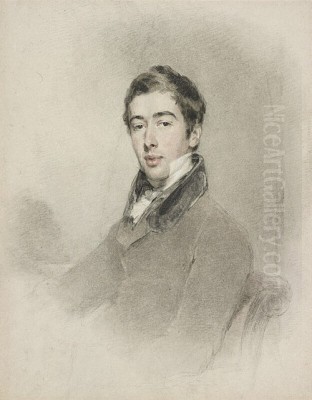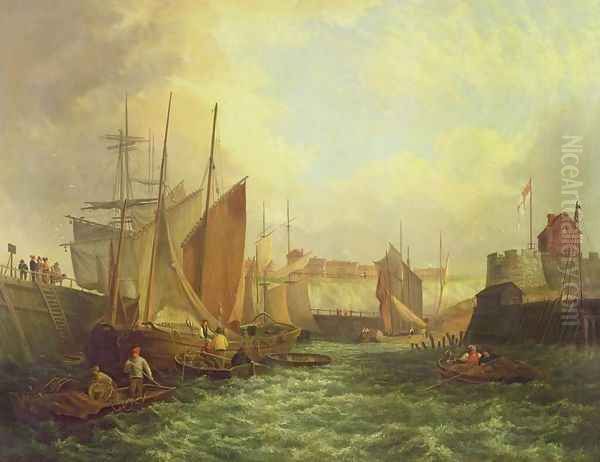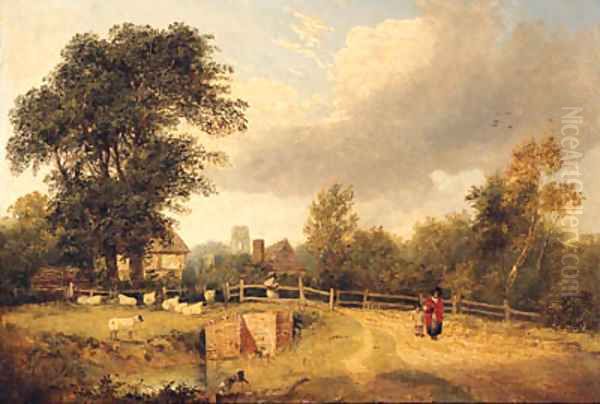
George Vincent, born in Norwich in June 1796, stands as a significant, albeit somewhat tragic, figure within the annals of British art history. An accomplished English landscape and marine painter, he was a prominent member of the Norwich School of painters, the first provincial art movement in Britain. His life, though relatively short and ending in obscurity around 1831, was marked by early promise, considerable talent, and a body of work that, at its best, captured the serene beauty of the English countryside and the dynamic allure of its coastal waters.
Early Life and Artistic Awakening in Norwich
Vincent's artistic journey began in his native Norwich, a city that, at the turn of the 19th century, was fostering a vibrant artistic community. His formal training was under the tutelage of John Crome, affectionately known as "Old Crome," a founding figure and the leading light of the Norwich School. Crome's influence on Vincent was profound, instilling in him a deep appreciation for the direct observation of nature and the subtle interplay of light and atmosphere that characterized the local Norfolk landscape.
By the tender age of fifteen, Vincent was already contributing his works to the Norwich Society of Artists' exhibitions, a testament to his precocious talent and dedication. This early exposure allowed him to hone his skills and gain recognition within the local art scene. His early works from this period likely reflected Crome's emphasis on naturalism, depicting the familiar woods, rivers, and heathlands surrounding Norwich with an emerging sensitivity and technical skill.
The Norwich School of Painters: A Provincial Renaissance
To understand George Vincent's artistic context, one must appreciate the significance of the Norwich School. Founded in 1803 by John Crome and Robert Ladbrooke, the Norwich Society of Artists aimed to provide a forum for local artists to exhibit their work and to foster a collective artistic identity rooted in the depiction of their immediate environment. This was a groundbreaking development, as London had hitherto been the undisputed center of the British art world.

The Norwich School drew heavily on the tradition of 17th-century Dutch Golden Age landscape painters, such as Jacob van Ruisdael, Meindert Hobbema, and Aelbert Cuyp. These masters were revered for their realistic portrayal of rural life, their meticulous attention to detail, and their masterful handling of light and shadow. John Crome, in particular, championed these qualities, and his teachings and personal example deeply influenced the younger generation, including Vincent, James Stark (another gifted pupil of Crome), and Joseph Stannard. John Sell Cotman, another towering figure of the Norwich School, though stylistically distinct with his bolder compositions and flatter planes of colour, also contributed to the school's reputation for innovation and quality. The collective output of these artists, and others like John Thirtle and Thomas Lound, created a distinct regional style that celebrated the understated beauty of East Anglia.
Artistic Development and Influences
Vincent's style, while firmly rooted in Crome's teachings, evolved to incorporate his own observations and sensibilities. His works are characterized by a careful rendering of natural detail, a harmonious use of colour, and an ability to capture the specific atmospheric conditions of a scene. Like Crome, he was drawn to the quiet charm of the Norfolk Broads, the rustic cottages, and the bustling river scenes. His marine paintings, a significant part of his oeuvre, demonstrate a keen understanding of maritime life and the ever-changing moods of the sea.
The influence of the Dutch masters is evident in his compositions, often featuring low horizons, expansive skies, and a focus on the everyday activities of rural and coastal communities. He shared with them an appreciation for the textures of the natural world – the roughness of tree bark, the transparency of water, the softness of clouds. This dedication to verisimilitude, combined with a poetic sensibility, gave his paintings a quiet dignity and enduring appeal. While his contemporaries in London, such as the great J.M.W. Turner and John Constable, were pushing the boundaries of landscape painting towards a more dramatic and Romantic expression, Vincent and his Norwich colleagues largely remained committed to a more intimate and localized vision.
Relocation to London and Wider Exhibitions
In 1819, seeking broader opportunities and recognition, George Vincent moved from Norwich to London. This was a common trajectory for ambitious provincial artists, as the capital offered access to major institutions, influential patrons, and a larger, more diverse art market. Between 1814 and 1823, even before his permanent move, Vincent had begun to exhibit his works beyond Norwich. He sent paintings to the prestigious Royal Academy of Arts, the Society of Painters in Water Colours (though primarily an oil painter, this indicates his engagement with the wider art scene), and the British Institution.

His presence in London continued to grow, and from 1824 until 1830, he became a regular exhibitor at the Suffolk Street Gallery, home to the Society of British Artists (now the Royal Society of British Artists). This society was established as an alternative to the Royal Academy, providing more exhibition opportunities for a wider range of artists. His participation in these exhibitions indicates a period of professional activity and a desire to establish his reputation on a national stage. During this time, he would have been aware of the works of other leading London-based artists, including portraitists like Sir Thomas Lawrence and genre painters such as David Wilkie, whose narrative scenes were immensely popular. Landscape watercolourists like Peter De Wint and David Cox were also highly active, contributing to the rich tapestry of early 19th-century British art.
Notable Works and Artistic Achievements
George Vincent is considered one of the most talented painters of the Norwich School. His oeuvre, though perhaps not as extensive as some of his longer-lived contemporaries, contains several notable pieces that showcase his skill and artistic vision. Among his most important works is the "Panoramic Landscape Painting of the River Yare in Norwich." This painting, true to its title, would have offered a sweeping view of the local river, a subject dear to the Norwich painters, likely imbued with the atmospheric qualities and attention to local character that defined the school.
Another significant work is "Greenwich Hospital from the River" (also referred to as "The View of Greenwich Hospital"). This painting, depicting the grand architectural complex on the banks of the Thames, was a popular subject for artists, allowing for a combination of topographical accuracy and picturesque effect. Its exhibition, possibly at the International Exhibition of 1862 (though this would have been posthumous, indicating its enduring value), speaks to its quality. "London from the Surrey Side of Waterloo Bridge" is another key painting, demonstrating his ability to tackle complex urban landscapes with the same sensitivity he applied to rural scenes. These works, alongside numerous depictions of Norfolk scenery, coastal views, and marine subjects, solidify his reputation as a versatile and accomplished painter. His handling of light, particularly in his river and coastal scenes, often evokes a serene, almost luminous quality.
A Promising Career Derailed by Intemperance
Despite his evident talent and early successes, George Vincent's career and life took a tragic turn. Historical accounts suggest that his artistic abilities were "debased by intemperance." This unfortunate development led to a decline in the quality of his output, with later works sometimes described as "mediocre and hastily finished." It is a sad, yet not uncommon, story in the art world, where personal struggles can overshadow professional achievements.
The exact nature of his "intemperance" is not explicitly detailed in most records, but it implies a lifestyle that was detrimental to his health and his art. This decline would have been particularly poignant given the high standards set by his mentor, John Crome, and the overall dedication to craftsmanship that characterized the Norwich School. The period of his most accomplished work seems to be concentrated in his earlier years and the initial period of his London career, before these personal difficulties began to take their toll. This phase of his life serves as a somber reminder of the fragility of talent when undermined by personal demons.
Final Years and Mysterious Disappearance
The consequence of this decline was that George Vincent gradually faded from public view. After his regular exhibitions at the Suffolk Street Gallery ceased around 1830, his presence in the art world diminished significantly. The precise circumstances of his final years are shrouded in some mystery. He is believed to have died around 1831, at the young age of approximately 35. The lack of detailed records concerning his death further contributes to the tragic narrative of a promising career cut short and ending in obscurity.
This disappearance contrasts sharply with the continued, albeit sometimes challenging, careers of his contemporaries. John Constable, for example, continued to produce groundbreaking work, while J.M.W. Turner was ascending to the zenith of his fame. Even within the Norwich School, artists like James Stark, despite his own health issues, and John Sell Cotman, despite financial struggles, maintained a more consistent presence. Vincent's early death and the preceding decline meant that his full potential was likely never realized.
Legacy and Historical Assessment
George Vincent's historical standing is that of a highly gifted but ultimately unfulfilled talent within the Norwich School. He is consistently praised for the quality of his best works, which place him in the upper echelons of the school, alongside figures like James Stark and Joseph Stannard, and just below the towering figures of John Crome and John Sell Cotman. His paintings are valued for their faithful depiction of English scenery, their technical proficiency, and their gentle, lyrical quality.
His contribution to the Norwich School lies in his adherence to its core principles of naturalism and his skilled interpretations of the local landscape and marine environments. His works can be found in various public collections, particularly in Norwich and other British museums, ensuring that his art continues to be appreciated. However, his relatively short career and the unfortunate circumstances of his later life have perhaps prevented him from achieving the wider international recognition of some of his British contemporaries like Constable or Turner, or even the more sustained national fame of Crome or Cotman.
Art historians recognize him as an important link in the Norwich School tradition, a direct inheritor of Crome's legacy. His paintings serve as valuable documents of early 19th-century English landscapes and maritime life, rendered with a skill that, at its peak, was considerable. The tragedy of his story often forms part of his assessment, a cautionary tale of talent compromised.
Contemporaries and the Artistic Milieu of Early 19th Century Britain
George Vincent worked during a dynamic period in British art. Landscape painting was gaining unprecedented prominence, with artists like J.M.W. Turner revolutionizing the genre with his dramatic, light-filled canvases, and John Constable championing a deeply personal and naturalistic approach to depicting the English countryside, particularly his native Suffolk. While Vincent's style was more aligned with the quieter realism of the Dutch tradition and the specific tenets of the Norwich School, he was undoubtedly aware of these broader trends.
Other notable landscape artists of the period included John Linnell, a friend and patron of William Blake, and later an accomplished landscape painter in his own right. The watercolour tradition was also flourishing, with artists like Samuel Palmer creating visionary landscapes, and figures such as Cornelius Varley and John Varley (who taught Linnell and Palmer) making significant contributions. In the realm of portraiture, Sir Thomas Lawrence dominated, while in genre painting, David Wilkie's scenes of everyday life enjoyed immense popularity. The art world was vibrant, with institutions like the Royal Academy, the British Institution, and newer societies like the Society of British Artists providing platforms for exhibition and debate. Vincent's move to London placed him at the heart of this milieu, even if his primary artistic allegiance remained with the Norwich School.
Conclusion: An Enduring, If Muted, Light
George Vincent's story is one of bright promise and poignant decline. As a key member of the second generation of Norwich School painters, he absorbed the lessons of his master, John Crome, and developed a distinctive voice in landscape and marine painting. His best works are characterized by their sensitivity to atmosphere, meticulous detail, and a deep affection for the English scene. His contributions to the Norwich exhibitions and his presence in the London art world for a time marked him as an artist of considerable ability and ambition.
While his career was tragically curtailed by personal issues and an early death, the paintings that survive stand as a testament to his talent. He remains an important figure for understanding the depth and richness of the Norwich School and its place within the broader context of British Romantic-era art. Though his light may have been muted prematurely, George Vincent's artistic legacy endures, offering a glimpse into the soul of a painter who, at his best, beautifully captured the enduring charm of the world around him. His life serves as a reminder of both the brilliance that can emerge from dedicated artistic communities and the personal vulnerabilities that can affect even the most gifted individuals.